NGC 2392
Taken 02/03/2025 with the LX200 at f10. 5m30s of RGB using the Atik 314+
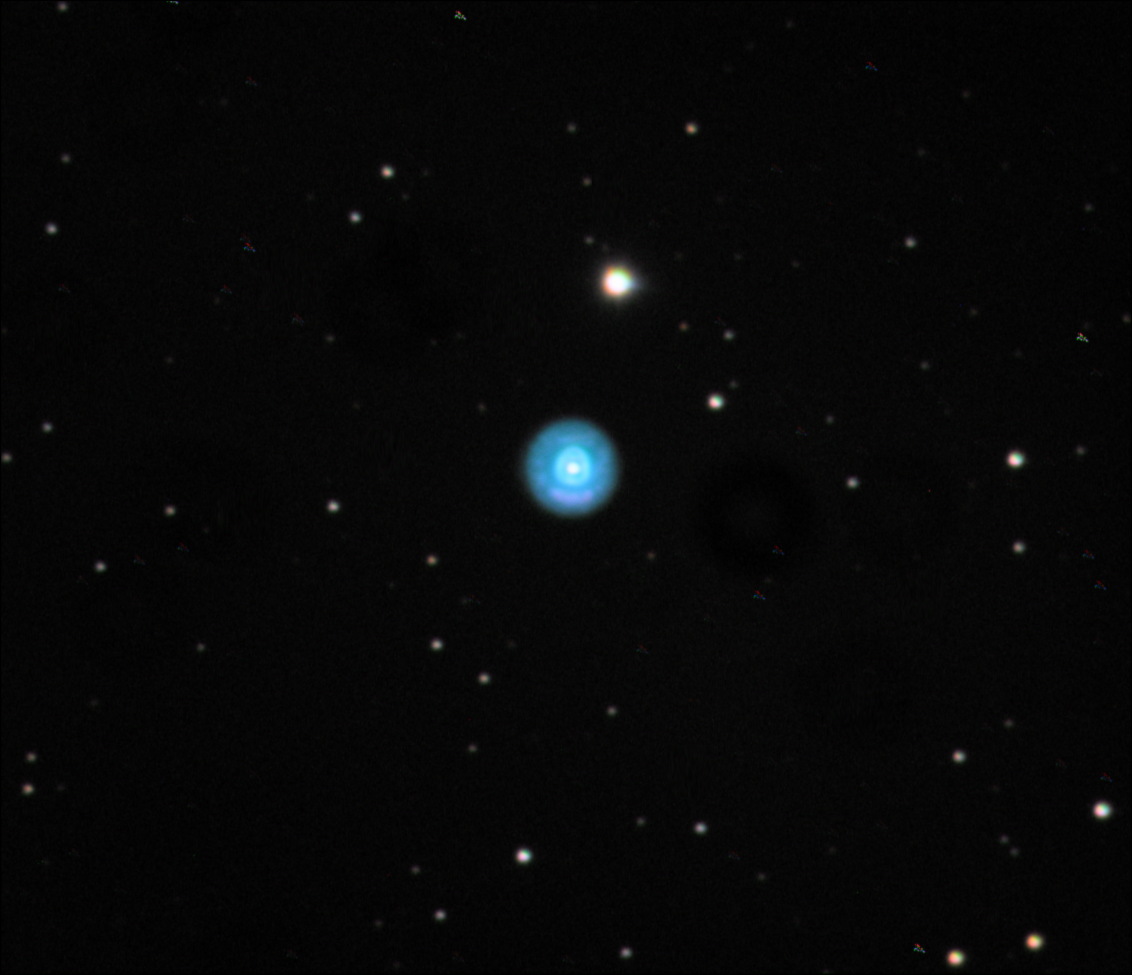
Taken 01/03/2025 with the LX200 at f10. 5m30s of RGB using the ASI 290MM
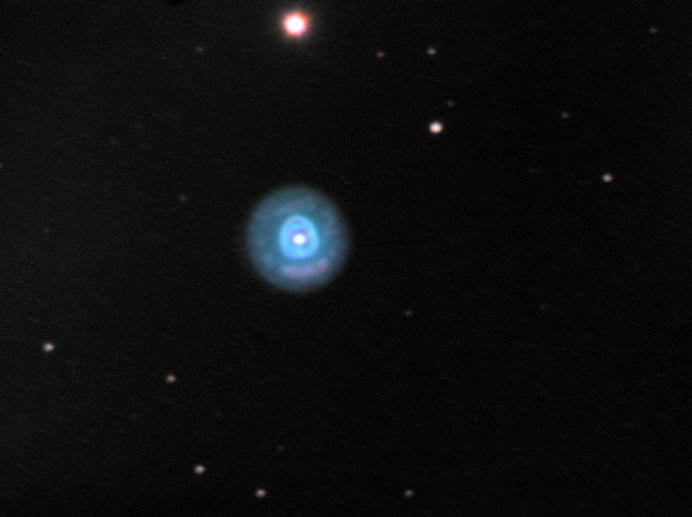
IC 1805
Taken 26/01/2024
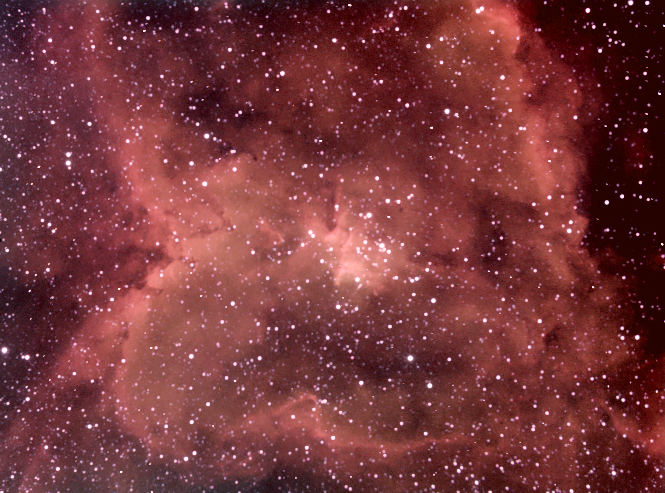
Outburst of RS Oph
RS Oph is a recurrent nova which is normally around magnitude 12.5 but flares up to magnitude 5 roughly every 15 years. The latest outburst began on 08/08/2021.
Below are some spectra with the SA100 and the LX200 at f6.3. Also an image of the general field with a 50mm tracking scope and a Skyris 445m camera. As time progresses it is clear that the Hα line becomes more dominant and the Helium and Iron lines also become much clearer.
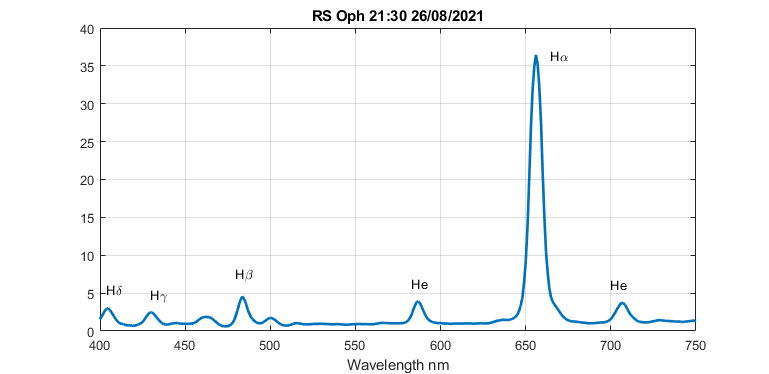
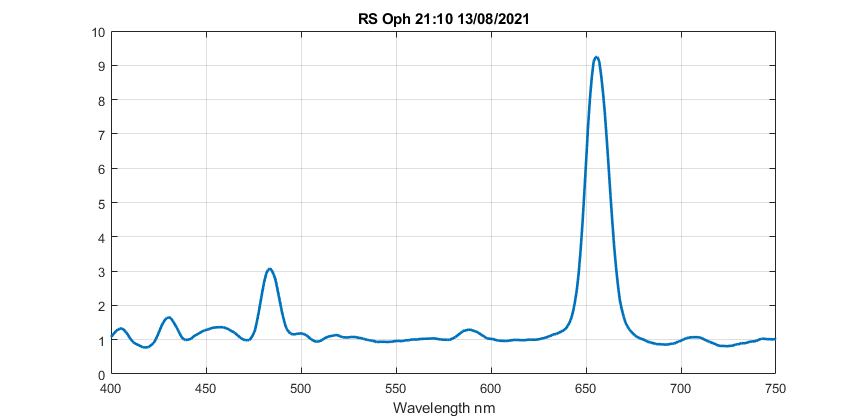
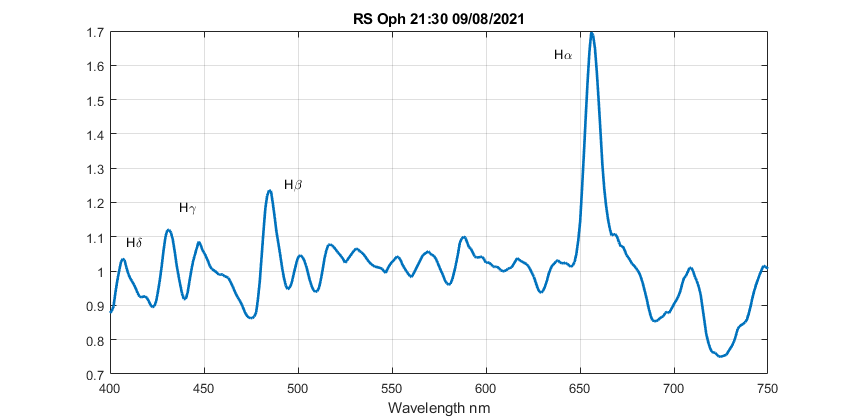
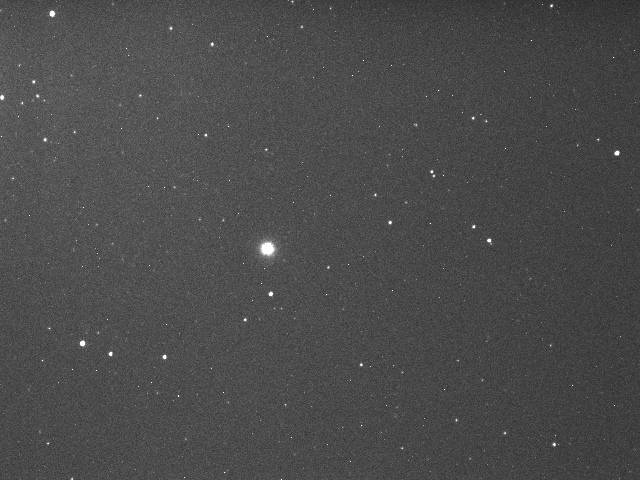
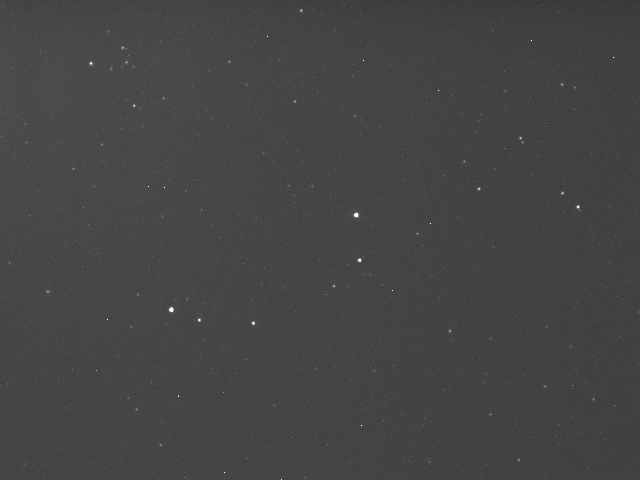
Seen below with the Canon 450. With virtually all its light at the Hα wavelength it is pretty red!
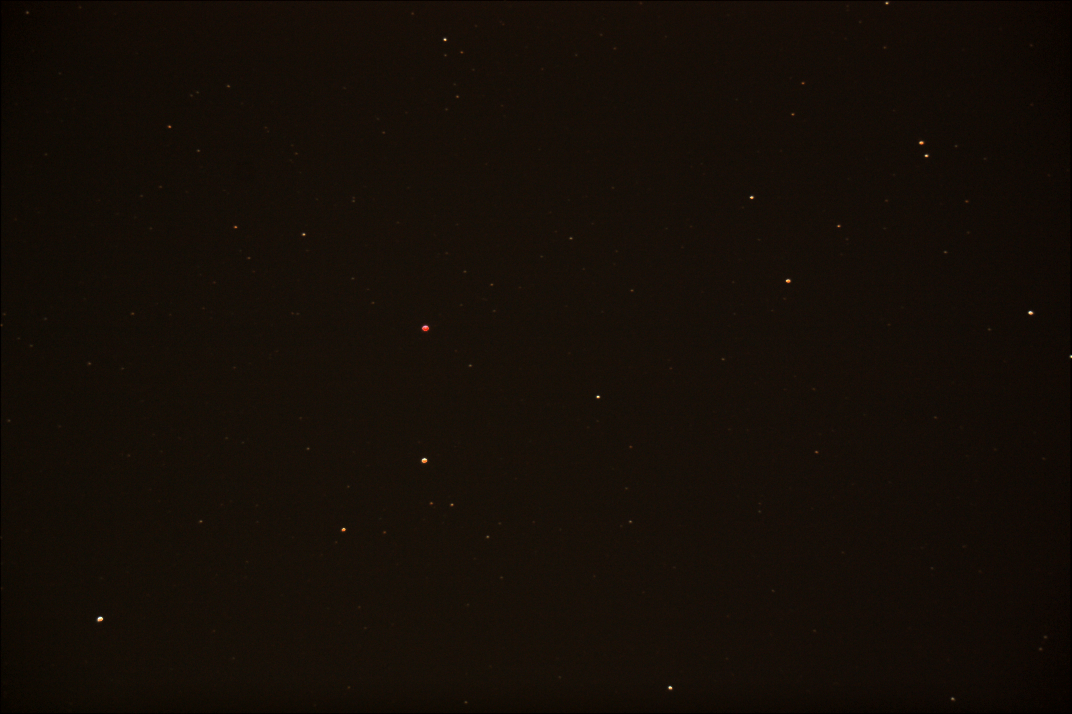
Nova in Perseus V1112
This is a classic nova in Perseus which reached around magnitude 9 in December 2020. These results are with the Star Analyser, the LX200 at f6.3 and 1 minute unbinned exposure on the Atik 3134L. The hydrogen alpha, beta and gamma lines are shown together with atmospheric oxygen absorption at around 760nm. The feature between Hβ and Hγ is unidentified assuming it’s not an artefact.
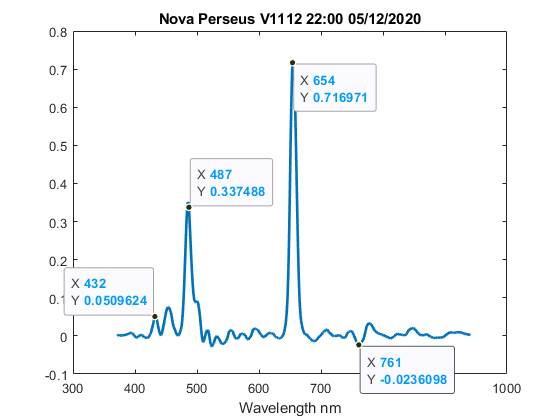

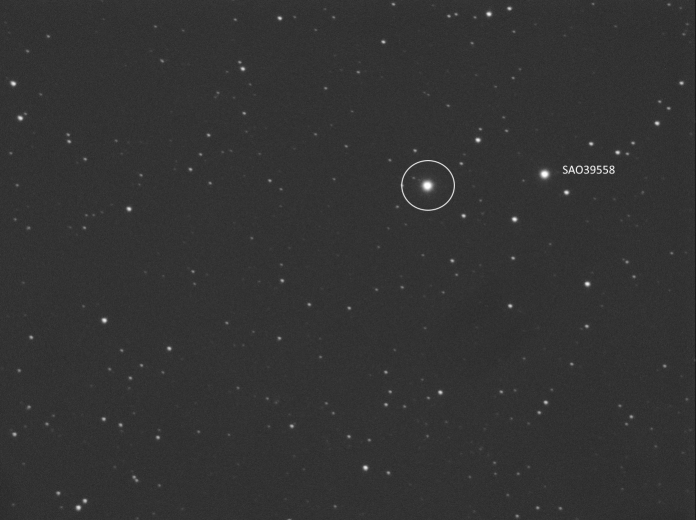
SN2020hvf in NGC3643
All data with the Atik 314L+ and LX200 at f6.3. Baader UV/IR cut for the image and Star Analyser 100 for the spectrum. Image from 14/05/2020 and spectrum 15/05/2020.
Stack of 7×3 minutes binned x2
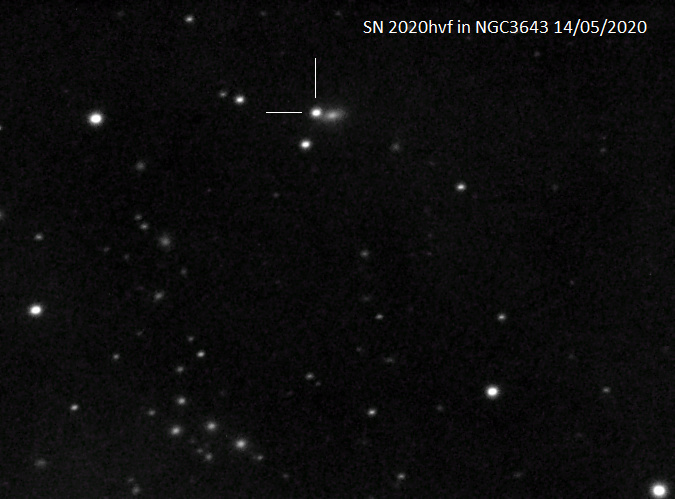
Stack of 17×3 minutes for the spectrum. Unbinned.
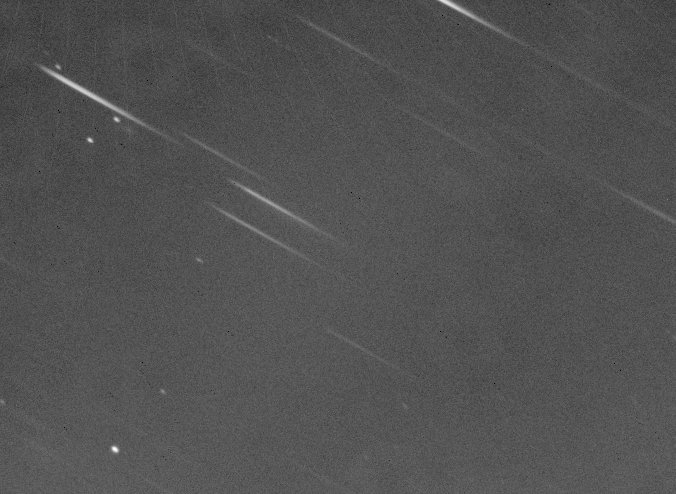
The SiII line is normally at 635nm but here the expansion caused by the explosion has blue shifted it to about 615nm.
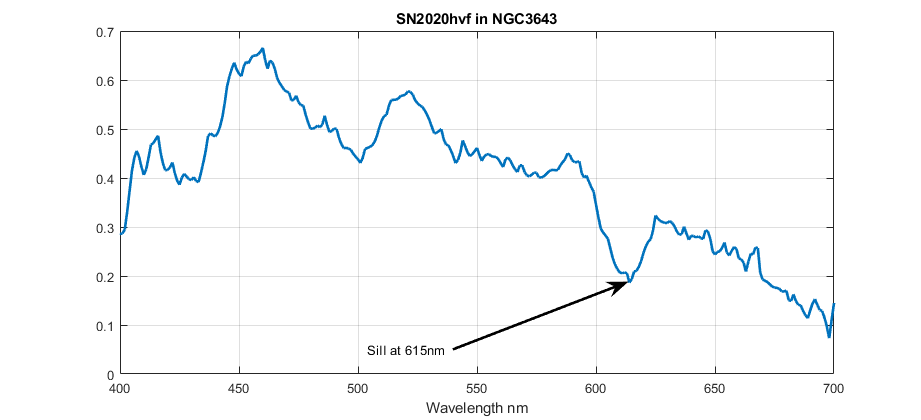
Comparison with a professional spectrum for a type 1a supernova
A brightness estimate from Astrometrica.
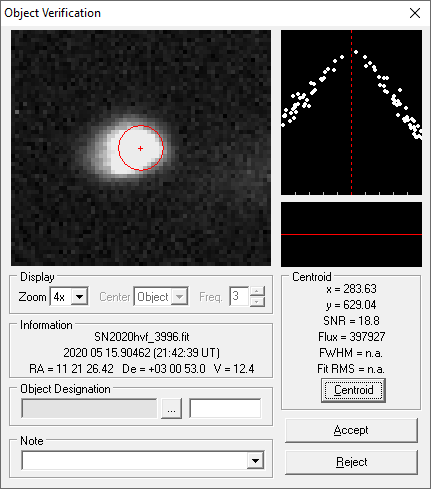
Some science
The SiII absorption band identifies this as a type Ia supernova which occurs when a white dwarf in a binary system accretes matter from its partner. Once the white dwarf mass reaches 1.4 solar masses (the Chandrasekhar limit) its gravity exceeds the electron degeneracy pressure and it should collapse into a neutron star. Apparently just before this limit is reached the star explodes and is completely destroyed.
The fact that the explosion occurs at a constant mass means all type Ia supernovae have close to the same intrinsic brightness with an absolute magnitude of -19.3 at 32.6 light years.
So a simple equation
Ma – Mb = 5 x log10 ( da/db )
where M is magnitude and d is distance. My measured magnitude is 12.4 hence
12.4 – (-19.3) = 5 x log10 ( da/ 32.6) which gives da=71M light years whereas the actual answer is 79M light years.
My SiII line is at 615nm compared to the rest value of 635nm hence a blue shift at
Velocity = change in wavelength / rest wavelength x speed of light = 20/635 x 300000 or 9500km/sec. The galaxy has a red shit corresponding to 1749km/sec which needs to be added on, so my value for the expansion velocity is 11249km/second. The accepted value is around 10,500km/sec.
Supernova 2020fqv in NGC4568
Taken with the Atik 314L+ and the LX200 at f6.3, RGB channels 8×3 minutes each. Astrometrica magnitude estimate for red was 15.6
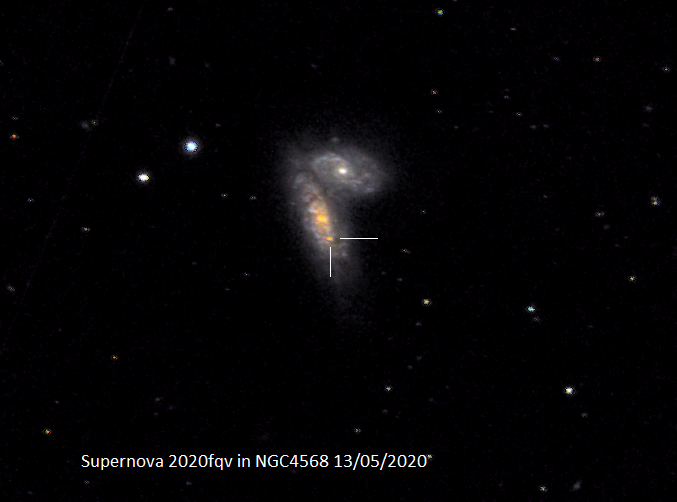
Supernova 2020jfo in M61
Taken with the Atik 314L+ and the LX200 at f6.3, UV/IR cut filter. 15×1 minute. Individual frame used for Astrometrica.
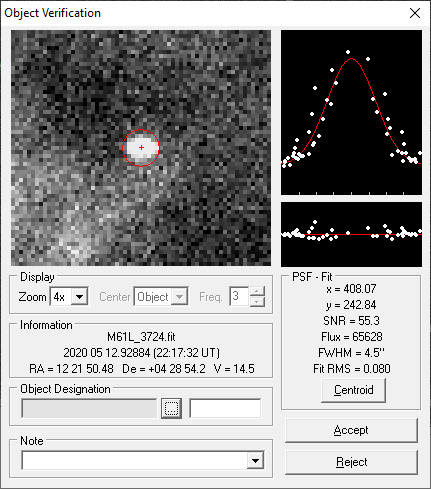
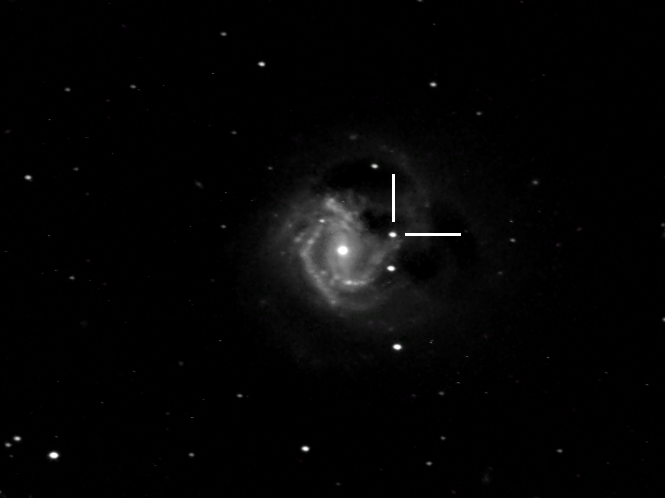
April 2020
M51 Galaxy
6×5 minutes each of RGB with the LX200 at f6.3. Binned 2×2
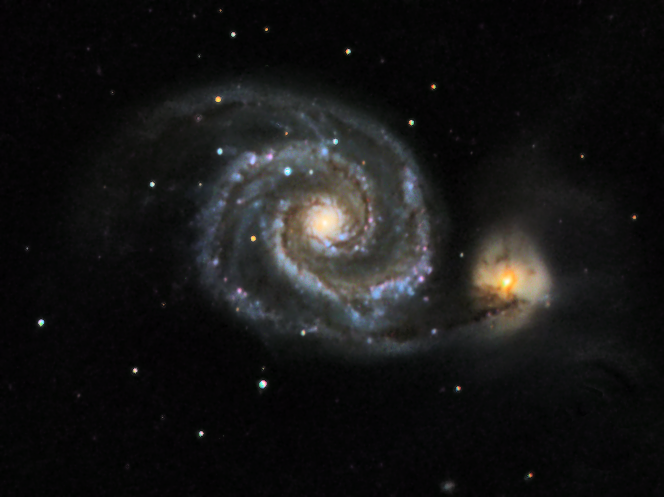
M81 Galaxy
4×10 minutes each of RGB with the LX200 at f6.3. Originally un-binned data but binned in software.
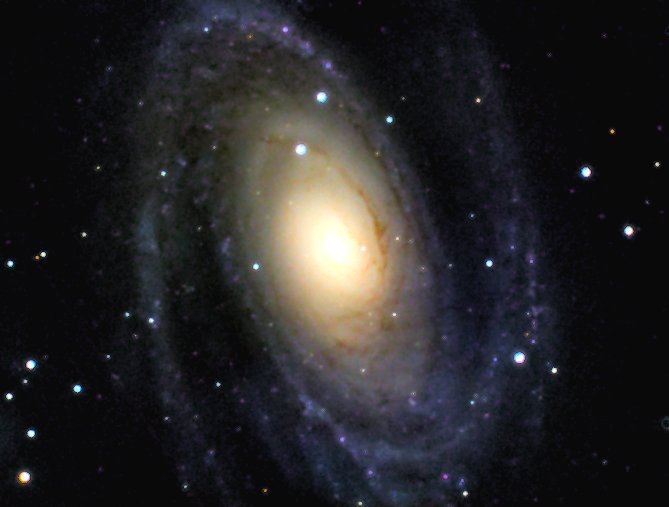
March 2020
M82 Galaxy in Ursa Major. 4×5 minutes each of RGB, Atik 314+, 10″ LX200 at f6.3
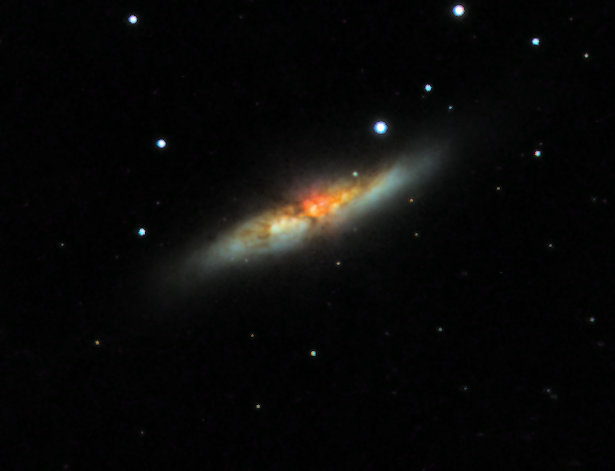
M81 galaxy from Altrincham. Some obvious problems with light pollution and flat field correction. About 40 minutes each of R, G and B with the LX200 at f3.3
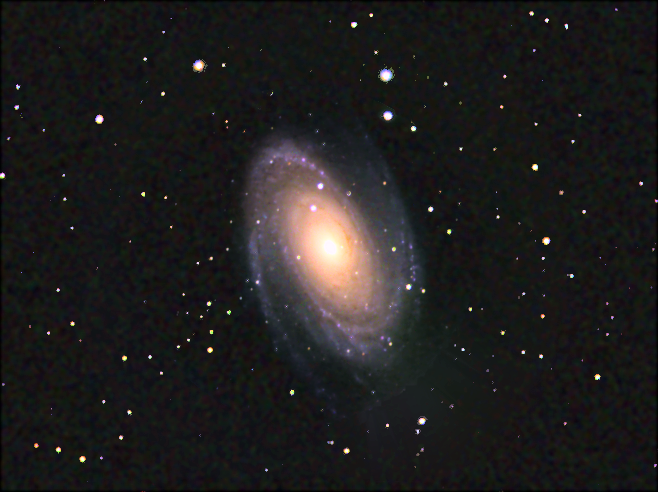
January 2020
M1 Crab nebula. 10″ LX200 at f3.3, 26×2 minutes of H alpha data with the Atik 314+
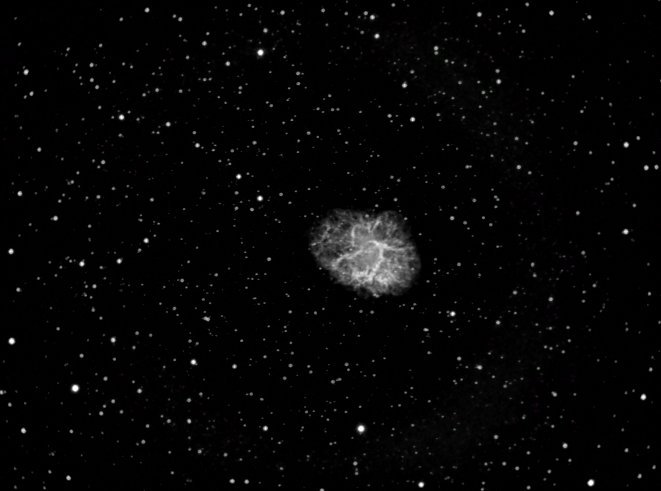
Also 26×2 minutes of H alpha and OIII data with the same set-up
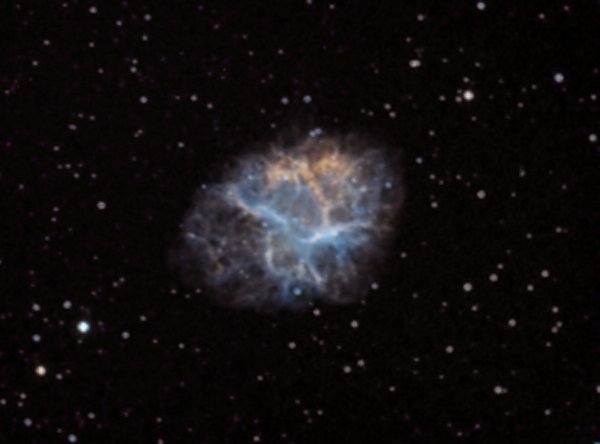
March 2019
The star cluster NGC1893 and nebula IC410 in Auriga. Taken on 07/03/2019 with the Skywatcher 80D at 300mm. 90 minutes of H alpha data. This was an unexpected clear period lasting a few hours after rain all day so the transparency was great and Auriga was almost overhead.
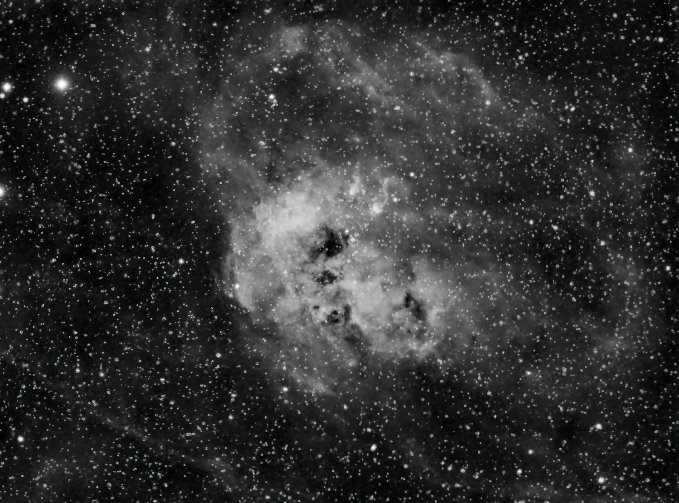
February 2019
IC443, Jellyfish nebula, 2h10m of H alpha data with the Skywatcher at 300mm. Taken on 27/02/2019 during a period of fine and warm weather.
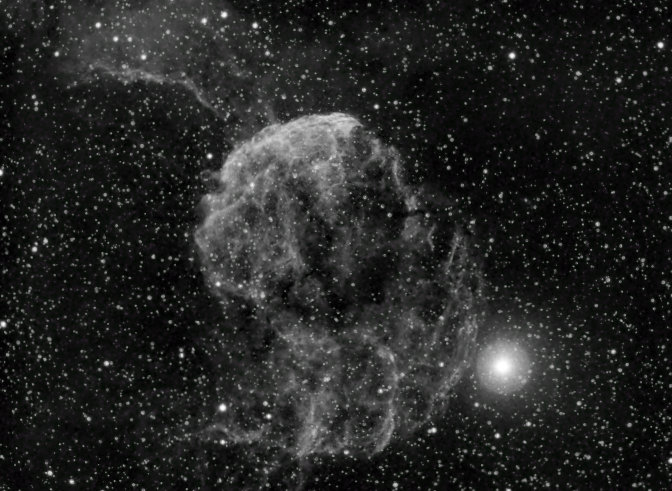
NGC1931 the Spider and fly nebula. 15X10 minutes of H alpha data, otherwise as below for Horsehead.
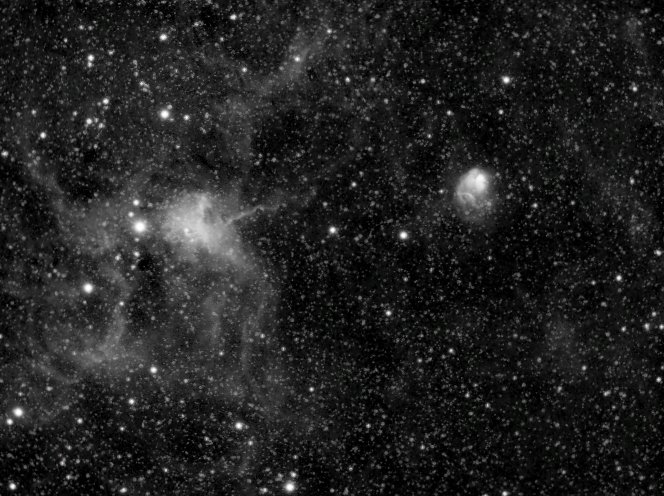
IC434 the Horsehead nebula and Flame nebula NGC 2024. 16×10 minutes with the Atik 314+ and Skywatcher 80D at 300mm using a Baader H alpha filter. Taken on 14/02/2019.
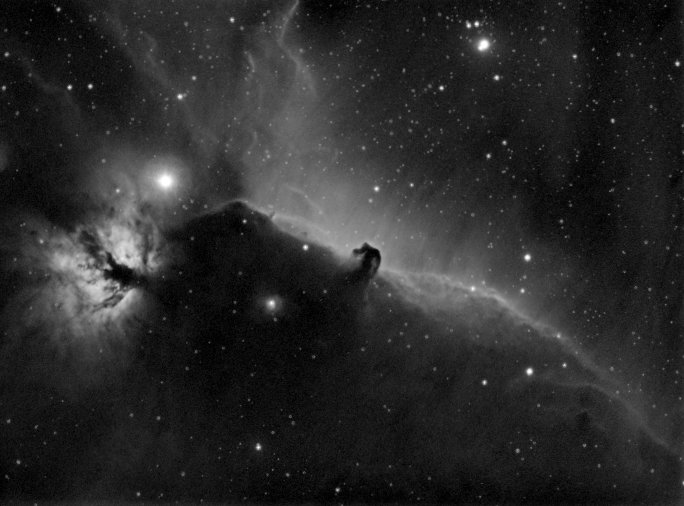
NGC2174 in narrowband with 40 minutes per channel of H alpha, OIII, SII. Taken on 11/2/2019. Transparency declined during the 2 hours so that the SII data was rather poor. Skywatcher 80D at 300mm focal length. Atik 314+
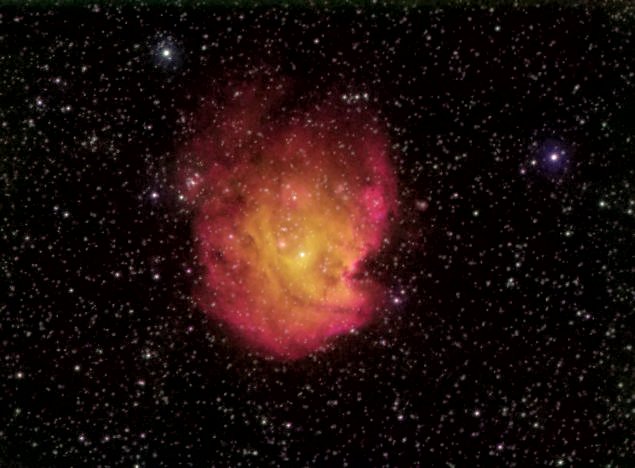
November 2018
Wizard Nebula NGC7380 with the Skywatcher 80ED at f6.25. Total exposure 2.5 hours of 5 minute subs in hydrogen alpha.
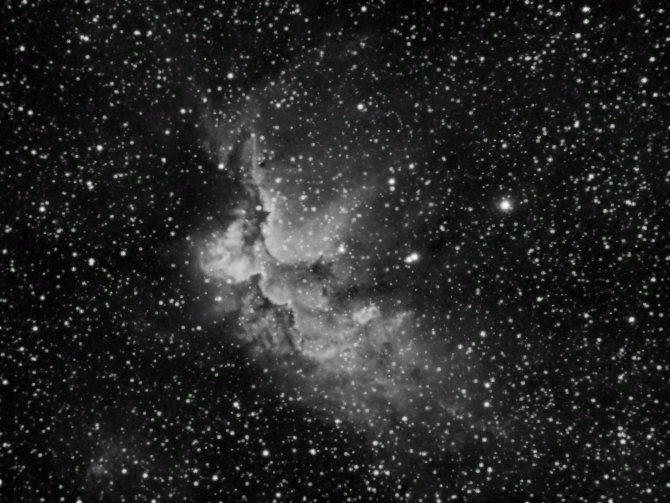
October 2018
Wizard Nebula NGC7380 in bi-colour with the LX200 at f3.3. About 1 hour of H Alpha and 2 hours of OIII with 2 minute sub-frames due to dodgy tracking. Processed in Star Tools with HA=Red and OIII=blue and green capped to brown.
The OIII in this image is minimal and with my light pollution I really need more data and probably a good flat field.
September 2018
Barnard dark nebulae 142 and 143 in Aquila with the Skywatcher 80. Integration of 10 minutes each for RGB channels with the Atik 314+.
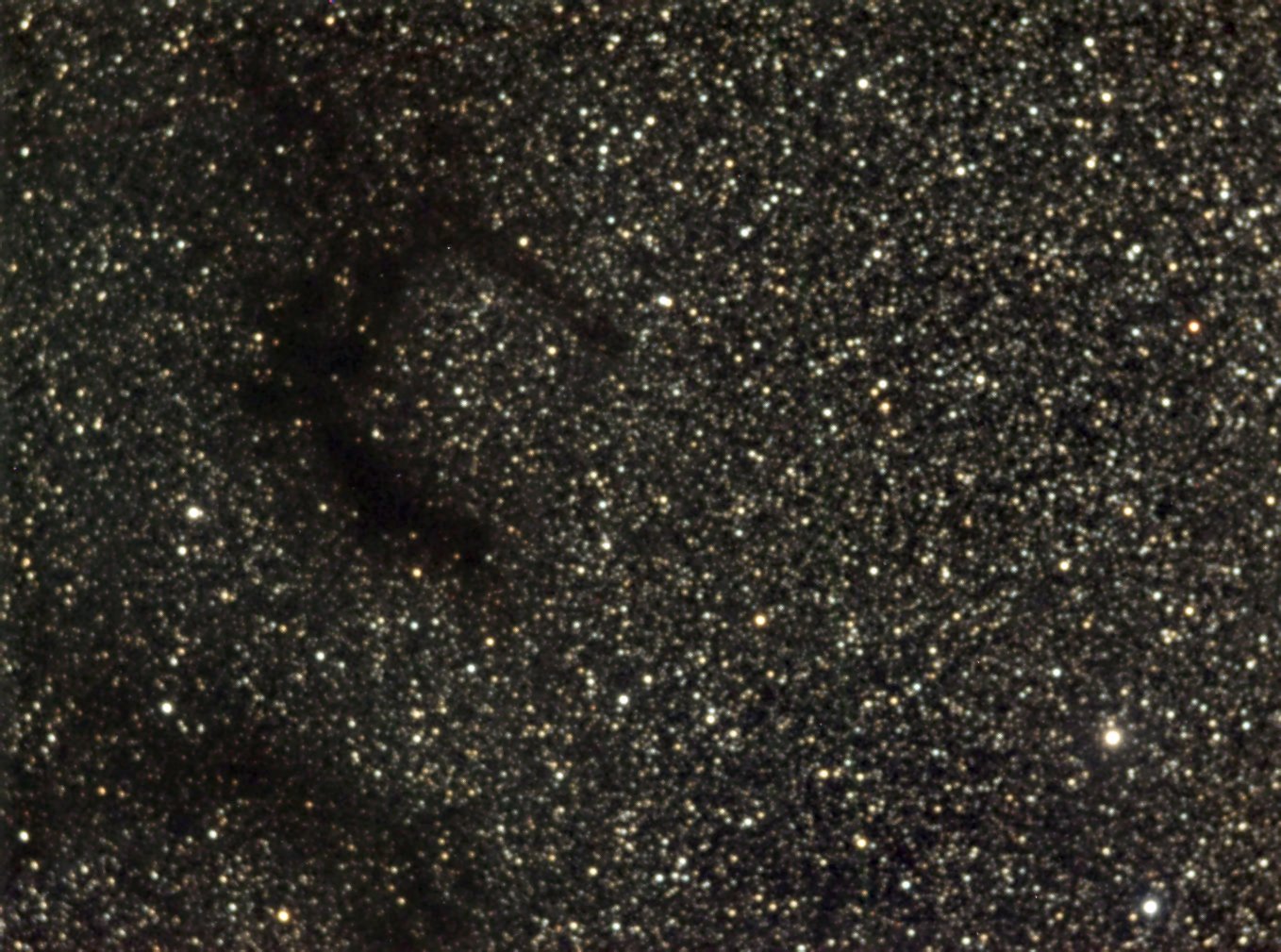
February 2018
The Lynx Quasar or APM 08279+5255 has a red shift of 3.9 and hence is about 12 billion light years distant. This makes it the most distant object that can be imaged by an amateur astronomer. The magnitude is 15.2 which is helped by gravitational lensing effect which increases its brightness by a factor of 4.
This image was taken with the LX200 at f3.3 with about 15 minutes per channel of RGB and 30 minutes of luminance. I used darks and flats. In the image it has an obvious red colour suggesting a wavelength of say 600nm however the original light was emitted at 1/4.9 of that value which is deep in the UV.
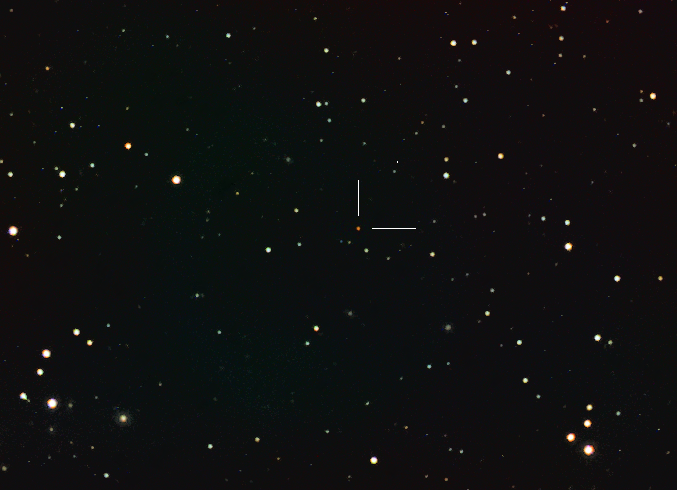
January 2018
Orion Nebula taken from Llyn Brenig in North Wales on 07/01/2018. A total of 90 minutes exposure in RGB using the Skywatcher 80ED and the Atik 314+. The temperature was -2C and there was a slight breeze but it was very dry and there were no clouds anywhere near to cause trouble.
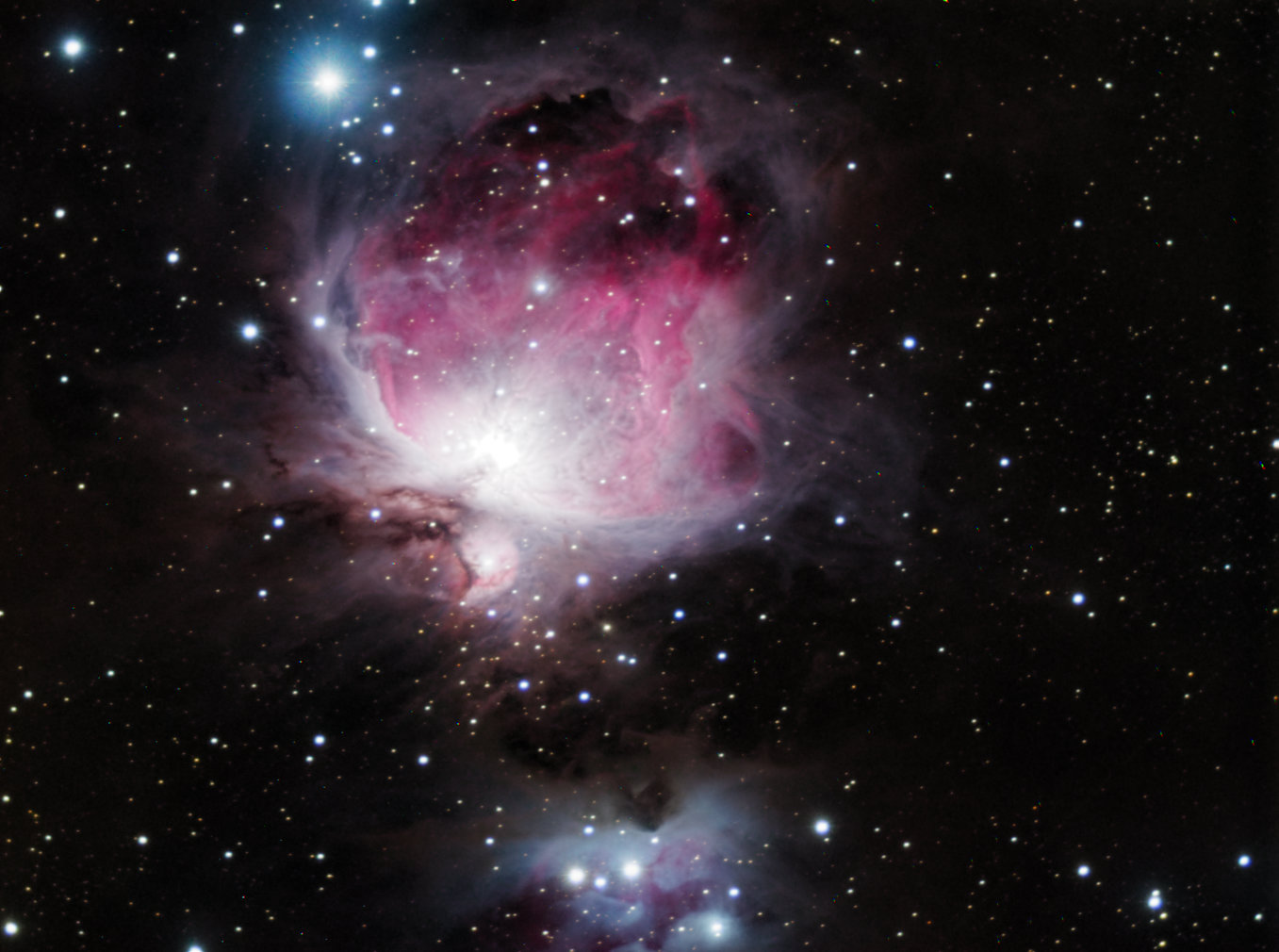
November 2017
Quasar 3C-48
At 4 billion light years this is easily the most distant object I have imaged. This is a stack of about 10 x 1 minute exposures of the Quasar 3C-48 in Triangulum. I used the Atik 314L+ at f3.3 with the 10″ LX200. The magnitude is 16.2
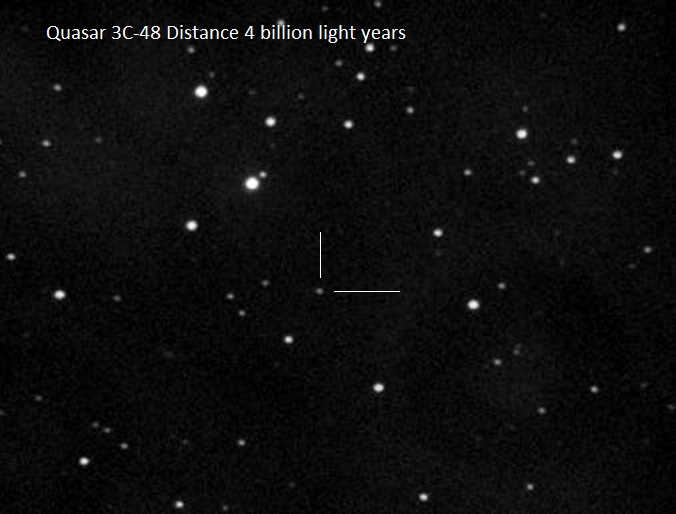
Einstein’s Cross and galaxy PGC 69457
In this image the ‘foreground’ galaxy is 400 million light years away. The object at its centre is not the galaxy’s core, but a distant quasar which is 8 billion light years away. The quasar is magnified due to the gravitational lensing effect of the the galaxy making it appear about 4 times brighter than it otherwise would be. At high resolution the quasar it can be seen that the lensing has produced as multiple images of the same object. 26×1 minute exposures at f3.3 with the 10″ LX200 taken on 12/11/2017.
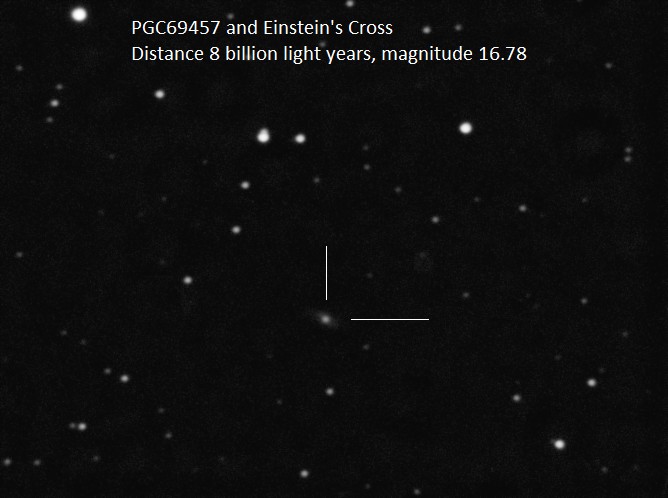
March 2017
Orion nebula on 25/03/2017 with 15 minutes of each narrow band channel. RGB assigned to Ha, SII, OIII respectively.
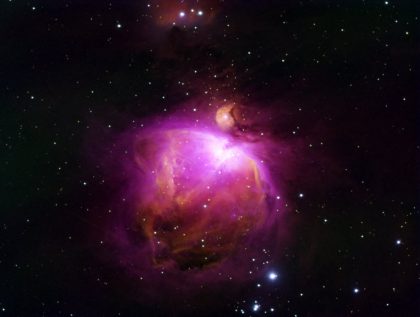
Now in colour using the Hubble SHO palette. The key to getting these colours in Start Tools is to reduce the green bias and cap the green.
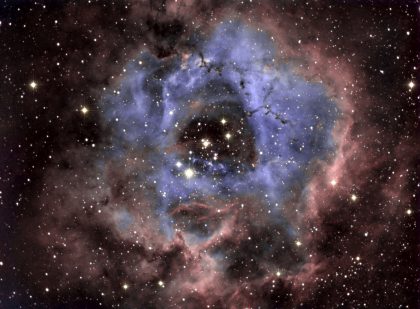
After enjoying 2 months of proper British weather, finally a clear night although only for a couple of hours. Here is the Rosette Nebula with 9×10 minutes of H alpha using the Skywatcher 80ED
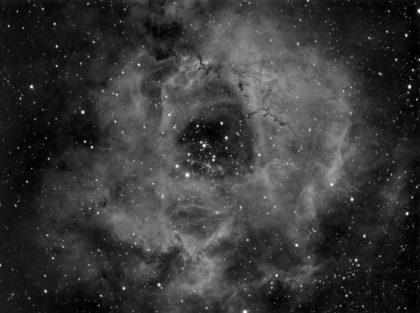
December 2016
IC434 Horsehead
NGC 281 Pacman nebula
1 each of hour of Hα and OIII data with the LX200 at f3.3 hence rather poor star shapes.
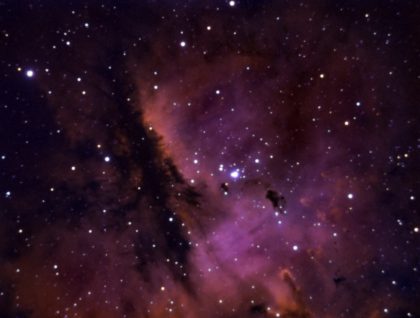
November 2016
Bubble Nebula NGC7635 and star cluster M52
75 minutes of OIII and Hα with the Skywatcher 80ED at 300mm. Taken on 25/11/2016. Processed with StarTools V1.3 (StarTools is highly recommended!)
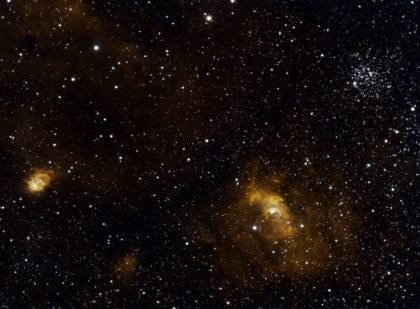
October 2016 Narrowband imaging
For some objects narrowband imaging can cut through the light pollution and produce a really good image. Here are some examples from the Autumn constelllations.
This image of M27 was taken with the LX200 and Atik 314+ at f3.3 on 02/10/2016. It uses the Hubble palette SII = Red, Hα = Green, OIII = Blue.
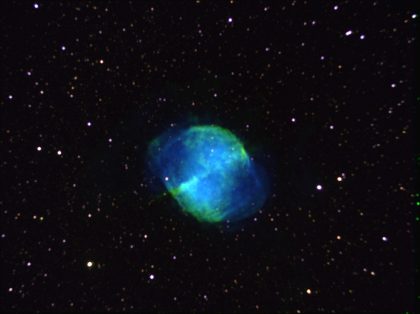
An image of NGC6992, the eastern veil nebula. Taken through a small gap in the clouds on 06/10/2016. Only 1 hour of data in total with the LX200 at f3.3.
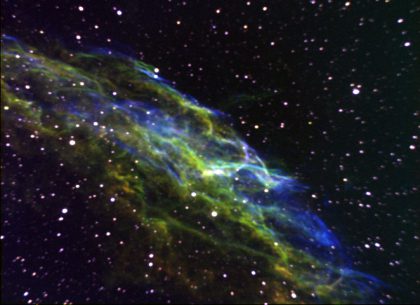
Version 2 with more data from 14/10/2016. Basically another hour of data. This was a completely clear night and the weather forecast said completely cloudy even a few hours before. Processed SHO again so the colour combination below applies. So the cyan wisps must be predominantly a mixture of OIII and Hα etc.
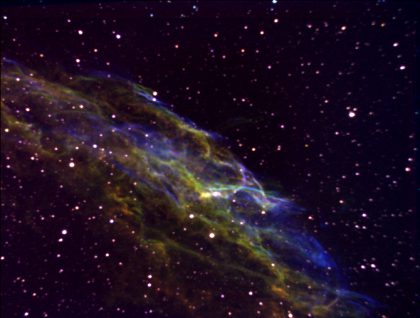
M17 more hydrogen alpha magic on 14/10/2016. This image isn’t great but it was a slightly hazy night, M17 was at 12 degrees altitude and there was full moon. So taking a nebula picture from a light polluted town should be impossible. Total 21 mins exposure at f3.3 on the LX200. The f3.3 reducer does produce obvious coma near the edges of the field but it’s worth it for the fast results.
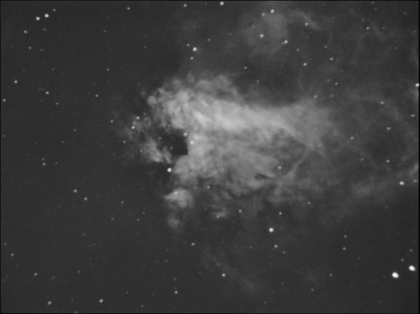
Bubble nebula 09/11/2015
Bubble nebula OIII and H alpha composite. The blue channel is synthetic and is based on OIII*Halpha. Taken from Altrincham with the LX200 at f3.3
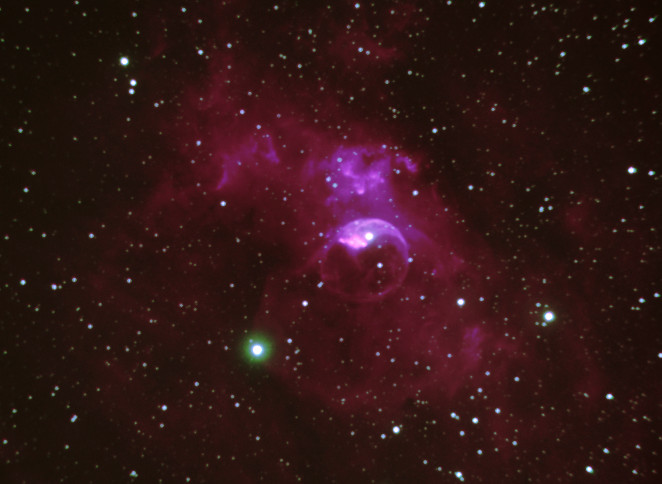
Llyn Brenig 21/03/2015
Rosette Nebula
Various different processing methods using the same data
Skywatcher 80ED, EQ3 mount, Atik 314L+, Orion guide scope with DBK
Leo triplet
M65 (right bottom), M66 (right top) and NGC 3628 (left).
Altrincham narrowband Results
Orion Nebula
Skywatcher Equinox 80 withAltair Lightwave 0.6x focal reducer. Atik 314L+ and Baader Hydrogen alpha filter. Taken from Altrincham
25/03/2017 with 15 minutes of each narrow band channel. RGB assigned to Ha, SII, OIII respectively

Horsehead Nebula
Skywatcher Equinox 80 withAltair Lightwave 0.6x focal reducer. Atik 314L+ and Baader Hydrogen alpha filter. Taken from Altrincham. 12 x 5 minute exposures. Note 7.5Ah battery flat after 2 hours, with cooled Atik 314L+, USB hub, Skywatcher drive and DBK guide camera. Atik is 0.8A (presumably including cooler), DBK is 0.5A
NGC7000 North Americ nebula
This image of NGC7000 or the North America Nebula was taken on 03/10/2016 with the Skywatcher 80ED and the Atik 314+. I used Baader planetarium H alpha, Oxygen III and Sulphur II filters. Exposure time was only 25 minutes per channel. The top version uses H-alpha = Red, OIII = Green, SII = Blue
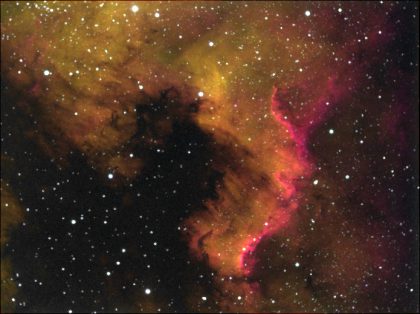
This version uses the Hubble palette again
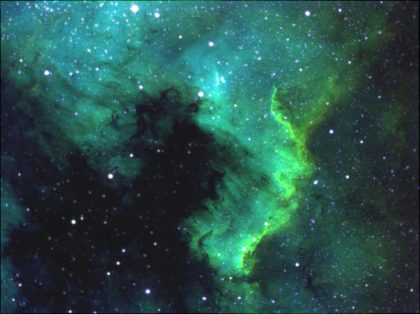
Veil Nebula
About 15 minutes per image. Taken on 15/09/2015
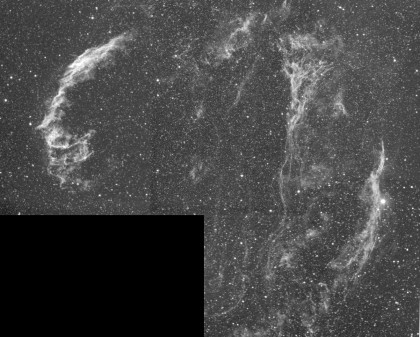
How to return to a previous place to take more data on another night
- In AstroTortilla solve the previous nights image and note the rotation
- Save the result as a bookmark
- Goto the focus star and solve/slew and sync unti it is central
- Note the rotation of any solution you get in this process and rotate to get the same rotation as the earlier data. Clockwise reduces the rotation angle.
- Goto the target again (NGC6995 is in the Caldwell list in EQTour)
- Load the bookmark and the scope should slew to the exact position as before
This image was taken on 10/11/2016 with 3×15 minutes of OIII and H alpha. Green synthesised as 0.25*Ha+0.75*OIII. Simple linear stretch only – absolutely nothing else.
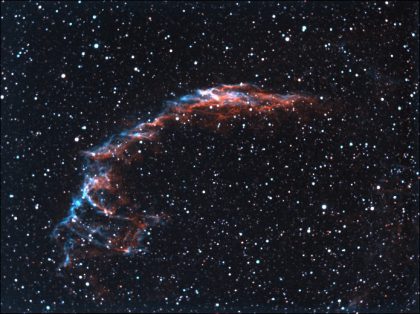
A Skywatcher version at 300mm, 15×3 minutes per channel in all 3 narrowbands. Taken 05/11/2016
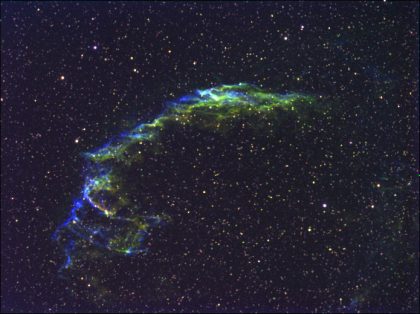
NGC6820
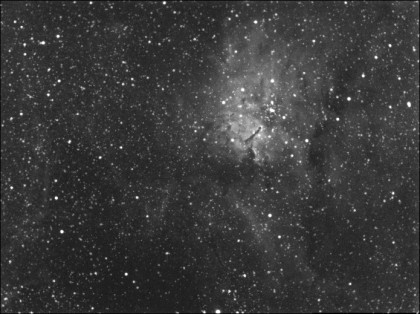
Taken 01/10/2015. A stack of 17×3 minutes out of 27 images. The EQ3 mount declination system seemed to go walk about on the others.
NGC7635 Bubble Nebula
This image taken with the 10″ LX200 at f3.3. Total exposure 78 minutes.
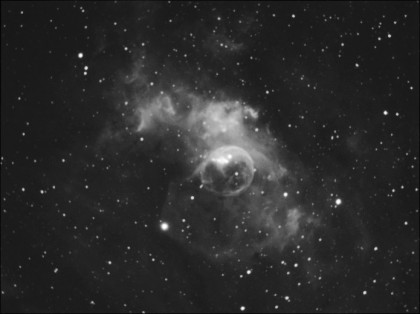
Astrometry solution
| Center (RA, Dec): | (350.145, 61.201) |
| Center (RA, hms): | 23h 20m 34.868s |
| Center (Dec, dms): | +61° 12′ 04.523″ |
| Size: | 26.1 x 19.5 arcmin |
| Radius: | 0.271 deg |
| Pixel scale: | 2.25 arcsec/pixel |
| Orientation: | Up is -160 degrees E of N |
M31 Borth-y-Gest and Llyn Brenig
LRGB using both data sets
Skywatcher Equinox 80 withAltair Lightwave 0.6x focal reducer. Atik 314L+ 14x2mins exposures from Borth-y-Gest. FOV is 1.66×1.24degrees.
Also colour from Lyn Brenig on 23/11/14. Rather poor focus.
Solution
| Center (RA, Dec): | (10.765, 41.252) |
| Center (RA, hms): | 00h 43m 03.628s |
| Center (Dec, dms): | +41° 15′ 06.267″ |
| Size: | 1.66 x 1.24 deg |
| Radius: | 1.039 deg |
| Pixel scale: | 4.31 arcsec/pixel |
| Orientation: | Up is 109 degrees E of N |
PHD2 reports pixel scale for the Orion 162mm finder and 5.6um pixel DBK is 7.13arcsec/pixel.Hence guding accuracy of 1 pixel would be equivalent to roughly 2 with the focal reducer
NGC7008 from Altrincham 12/11/2014.
LX200 at f6.3 and L=33x1min, RGB=15x1min. Processed in DSS and Gimp
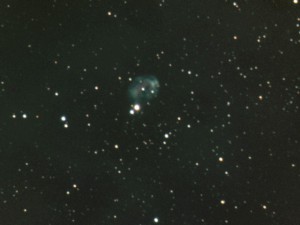
M81/M82 from Morfa Nefyn 18/04/2014
- Skywatcher Equinox 80
- EQ3 mount
- Guiding with Orion 50mm guide scope, DBK21AU04 and PHD
- Initial acquisition with Astrototilla.
- Atik 314L+ camera with RGB filters, 30 mins luminance and 10 mins each of RGB binned 2×2
M51 from Llyn Brenig 23/03/2014
Processed in GIMP. Top RGB no dark frames, bottom LRGB with dark frames
Rosette from Llyn Brenig 23/03/2014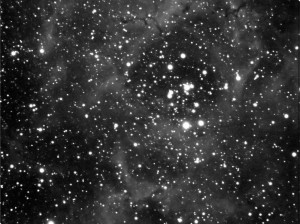
M42 10/03/2014
M42 Orion Nebula 03/03/2014
M42 transit times 15 Dec=00:00, 1 Jan= 23:00, 15 Jan=22:01, 1 Feb= 20:58, 14 Feb =20:06
This image resulted from a first fully successful test of my Skywatcher ED80 kit. It was taken by Rob Holmes and me from my back garden as a rehearsal for our planned dark sky trip to Wales.
The set up was fully battery powered with the computer at one end of a 10m USB cable and at the other end a 12v powered USB Hub. We used Cartes du Ciel for initial aiming and set-up of the mount, then PHD Guiding during the capture. The Skywatcher has an Orion 50mm Guidescope mounted on it and the guiding camera is an Imaging Source DBK21AU04. The main camera is an Atik 3134L+. We only managed 4 minutes each of LRGB channels.
Here’s some different processing with a bit of a blue boost. The main problem with the images was that the blue channel was out of focus, either because the filter isn’t parfocal or (more likely) I knocked the focus when I moved the filter wheel.
Other Skywatcher 80ED images
http://www.blackwaterskies.co.uk/2014/01/m42-plus-m43-unmodded-dslr-image.html
http://cs.astronomy.com/asy/m/nebulae/488446.aspx
https://www.flickr.com/groups/skywatcher-80ed/pool/14280933@N08/
Supernova SN2014J in M82
Imaged on 31/02/2014. This is a type 1a supernova as shown by the Silicon II absorption. M82 galaxy is about 12M light years away
Orion 50mm Guidescope and DBK 69.9×52.4arcmin and 6.55 arcsec/pixel
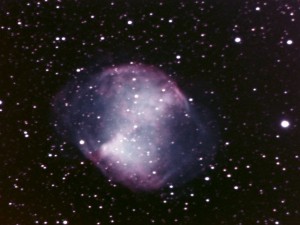 First test of Opticstar LRGB colour filter set 05/10/2013. M27 with 15 minutes per channel on Atik 314L and LX200 10″ at f6.3. L binned 2×2 others 4×4. Stacked in DSS then combined in Paintshop using CMYK (C=R, M=G, Y=B, K=L) and negative. L channel was processed using histogram and gamma. Others adjusted for reasonably dark background then the combination adjusted with contrast and brightness and colour balance. Contrast really brings out the colours.
First test of Opticstar LRGB colour filter set 05/10/2013. M27 with 15 minutes per channel on Atik 314L and LX200 10″ at f6.3. L binned 2×2 others 4×4. Stacked in DSS then combined in Paintshop using CMYK (C=R, M=G, Y=B, K=L) and negative. L channel was processed using histogram and gamma. Others adjusted for reasonably dark background then the combination adjusted with contrast and brightness and colour balance. Contrast really brings out the colours.
M27 Dumbbell Nebula
A calibration image for the Atik and Skywatcher of M27 (without 0.6 focal reducer)
| Center (RA, Dec): | (299.885, 22.653) |
| Center (RA, hms): | 19h 59m 32.386s |
| Center (Dec, dms): | +22° 39′ 11.278″ |
| Size: | 61.2 x 45.8 arcmin |
| Radius: | 0.637 deg |
| Pixel scale: | 2.66 arcsec/pixel |
An image of a nova in Delphinus taken on 16/08/2013 at 21:50BST . Canon 450 and LX200 at f6.3. Image size is 39.8 x 26.5 arcmin and centred at (RA,Dec) 305.863, 20.728.
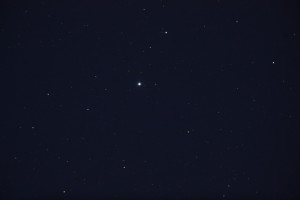
This is a first light image with an Atik 314L + taken on 30/05/2013 at around 22:00GMT. It’s M51 at f3.3 with the LX200 and only 4×1 minute exposure. After that it clouded over.
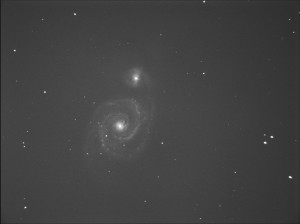
A single frame with the Canon 450D and the 80mm ED /f=500mm/f6.25 Skywatcher Equinox calibrated by http://nova.astrometry.net/upload. Image is binned x4 and hence 1070×712 pixels from 4272×2848. Canon chip is 22.2×14.8mm hence the Atik 314 at 8.98×14.8mm should be 1.02×1.7 degrees
| Center (RA, Dec): | (84.098, -5.331) |
| Center (RA, hms): | 05h 36m 23.638s |
| Center (Dec, dms): | -05° 19′ 52.512″ |
| Size: | 2.56 x 1.7 deg |
| Radius: | 1.535 deg |
| Pixel scale: | 8.6 arcsec/pixel |
| Orientation: | Up is 176 degrees E of N |

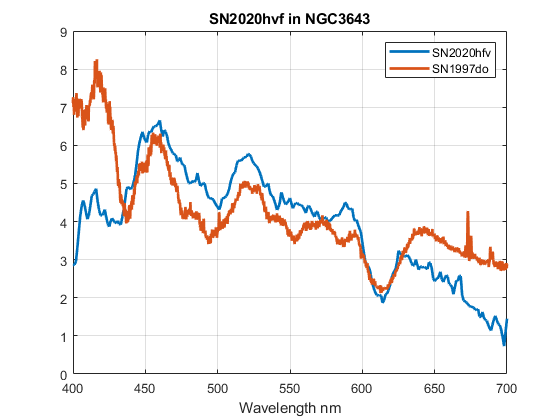
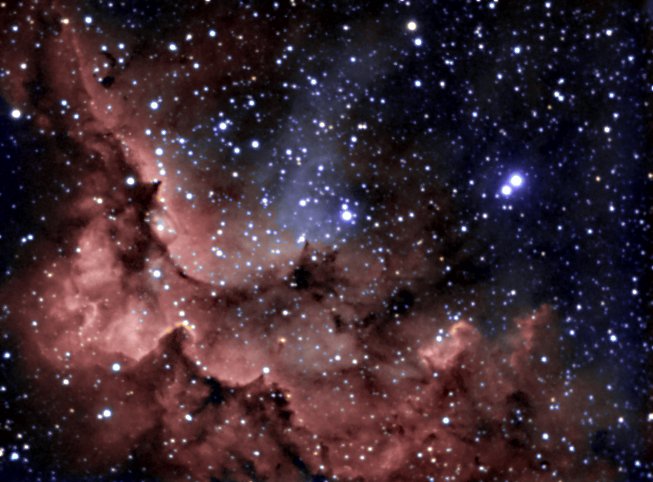
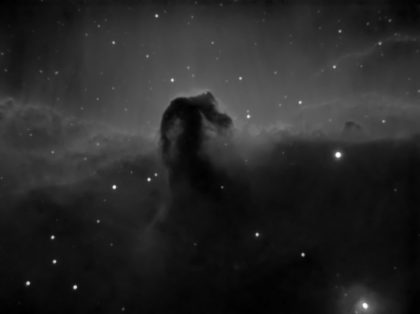
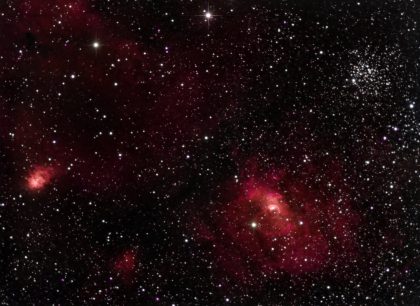
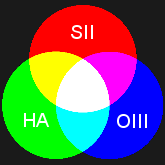
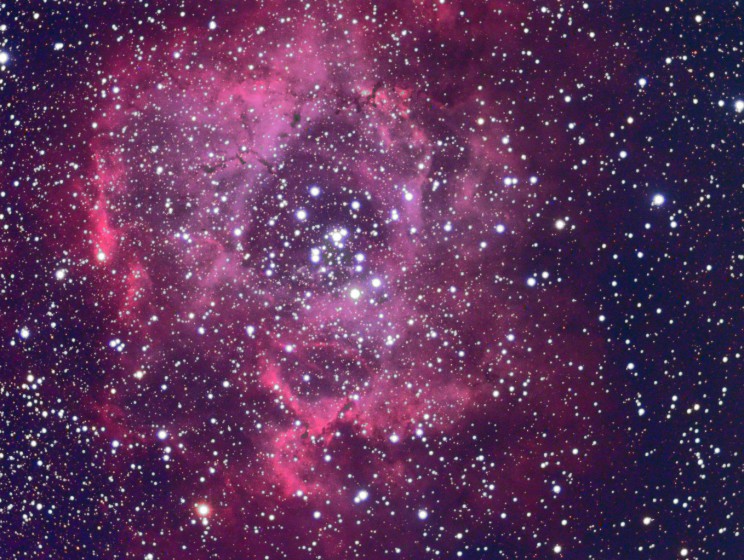
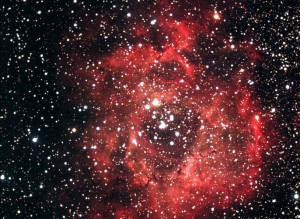
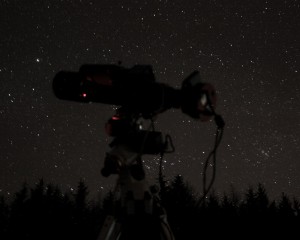
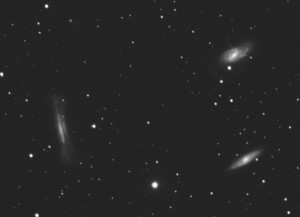
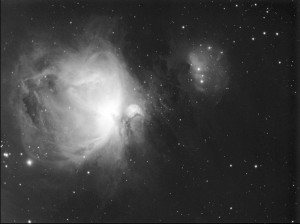
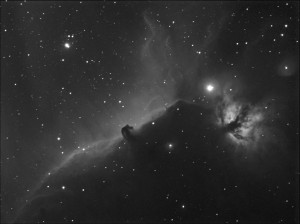
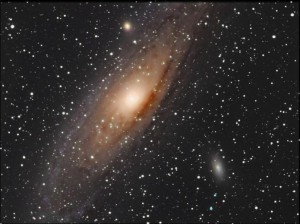
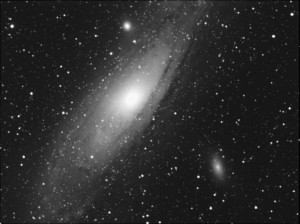
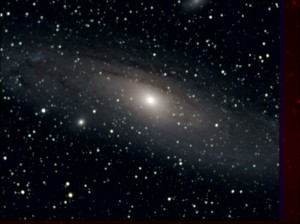
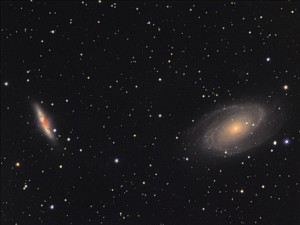
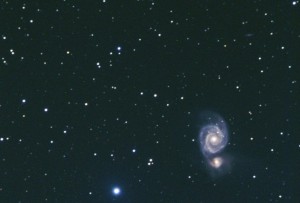
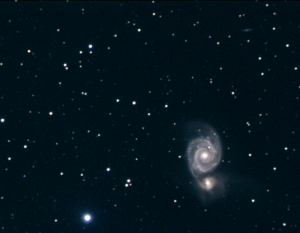
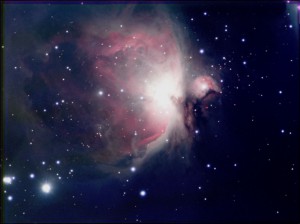
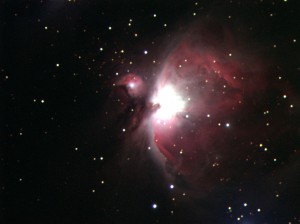
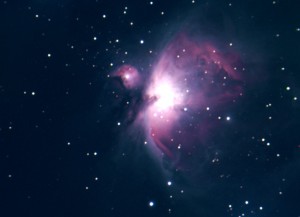
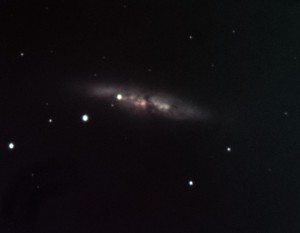
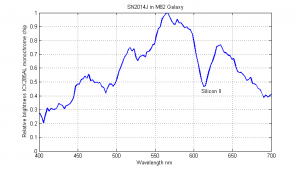
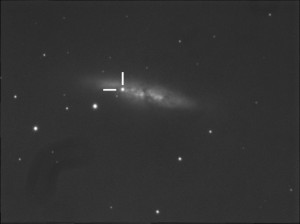
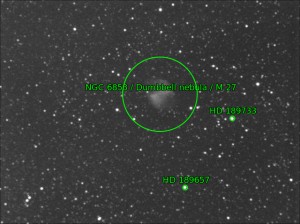
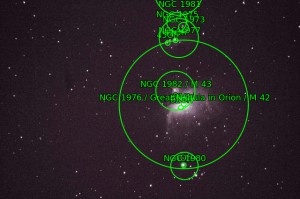
I would love to see some Lunar eclipse pictures!